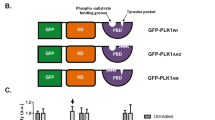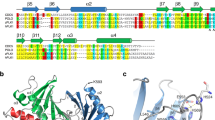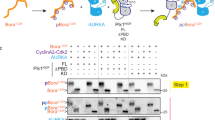Abstract
The small family of polo-like kinases (Plks) includes Cdc5 from Saccharomyces cerevisiae, Plo1 from Schizosaccharomyces pombe, Polo from Drosophila melanogaster and the four mammalian genes Plk1, Prk/Fnk, Snk and Sak. These kinases control cell cycle progression through the regulation of centrosome maturation and separation, mitotic entry, metaphase to anaphase transition, mitotic exit and cytokinesis. Plks are characterized by an N-terminal Ser/Thr protein kinase domain and the presence of one or two C-terminal regions of similarity, termed the polo box motifs. These motifs have been demonstrated for Cdc5 and Plk1 to be required for mitotic progression and for subcellular localization to mitotic structures. Here we report the 2.0 Å crystal structure of a novel domain composed of the polo box motif of murine Sak. The structure consists of a dimeric fold with a deep interfacial cleft and pocket, suggestive of a ligand-binding site. We show that this domain forms homodimers both in vitro and in vivo, and localizes to centrosomes and the cleavage furrow during cytokinesis. The requirement of the polo domain for Plk family function and the unique physical properties of the domain identify it as an attractive target for inhibitor design.
This is a preview of subscription content, access via your institution
Access options
Subscribe to this journal
Receive 12 print issues and online access
$189.00 per year
only $15.75 per issue
Buy this article
- Purchase on Springer Link
- Instant access to full article PDF
Prices may be subject to local taxes which are calculated during checkout




Similar content being viewed by others
Accession codes
References
Donaldson, M.M., Tavares, A.A., Hagan, I.M., Nigg, E.A. & Glover, D.M. J. Cell Sci. 114, 2357–2358 (2001).
Glover, D.M., Hagan, I.M. & Tavares, A.A. Genes Dev. 12, 3777–3787 (1998).
Nigg, E.A. Curr. Opin. Cell Biol. 10, 776–783 (1998).
Sunkel, C.E. & Glover, D.M. J. Cell. Sci. 89, 25–38 (1988).
Carmena, M. et al. J. Cell Biol. 143, 659–671 (1998).
Ohkura, H., Hagan, I.M. & Glover, D.M. Genes Dev. 9, 1059–1073 (1995).
Simchen, G., Kassir, Y., Horesh-Cabilly, O. & Friedmann, A. Mol. Gen. Genet. 184, 46–51 (1981).
Song, S. & Lee, K.S. J. Cell. Biol. 152, 451–469 (2001).
Hudson, J.W. et al. Curr. Biol. 11, 441–446 (2001).
Lee, K.S. & Erikson, R.L. Mol. Cell. Biol. 17, 3408–3417 (1997).
Ouyang, B. et al. J. Biol. Chem. 272, 28646–28651 (1997).
Golsteyn, R.M., Mundt, K.E., Fry, A.M. & Nigg, E.A. J. Cell Biol. 129, 1617–1628 (1995).
Lee, K.S., Grenfell, T.Z., Yarm, F.R. & Erikson, R.L. Proc. Natl. Acad. Sci. USA 95, 9301–9306 (1998).
Wang, Q. et al. Mol. Cell. Biol. 22, 3450–3459 (2002).
Song, S., Grenfell, T.Z., Garfield, S., Erikson, R.L. & Lee, K.S. Mol. Cell. Biol. 20, 286–298 (2000).
Mulvihill, D.P., Petersen, J., Ohkura, H., Glover, D.M. & Hagan, I.M. Mol. Biol. Cell 10, 2771–2785 (1999).
Adams, R.R., Tavares, A.A., Salzberg, A., Bellen, H.J. & Glover, D.M. Genes Dev. 12, 1483–1494 (1998).
Madej, T., Gibrat, J.F. & Bryant, S.H. Proteins 23, 356–369 (1995).
Wheeler, D.L. et al. Nucleic Acids Res. 30, 13–16 (2002).
Schultz, J., Milpetz, F., Bork, P. & Ponting, C.P. Proc. Natl. Acad. Sci. USA 95, 5857–5864 (1998).
Falquet, L. et al. Nucleic Acids Res. 30, 235–238 (2002).
Jang, Y.J., Lin, C.Y., Ma, S. & Erikson, R.L. Proc. Natl. Acad. Sci. USA 99, 1984–1989 (2002).
Ho, Y. et al. Nature 415, 180–183 (2002).
Feng, Y. et al. Biochem. J. 339, 435–442 (1999).
Hu, F. et al. Cell 107, 655–665 (2001).
Bahler, J. et al. J. Cell Biol. 143, 1603–1616 (1998).
Smits, V.A. et al. Nature Cell Biol. 2, 672–676 (2000).
Simizu, S. & Osada, H. Nature Cell Biol. 2, 852–854 (2000).
Wolf, G. et al. Oncogene 14, 543–549 (1997).
Dietzmann, K., Kirches, E., von Bossanyi, P., Jachau, K. & Mawrin, C. J. Neurooncol. 53, 1–11 (2001).
Tokumitsu, Y. et al. Int. J. Oncol. 15, 687–692 (1999).
Knecht, R. et al. Cancer Res. 59, 2794–2797 (1999).
Smith, M.R. et al. Biochem. Biophys. Res. Commun. 234, 397–405 (1997).
Cogswell, J.P., Brown, C.E., Bisi, J.E. & Neill, S.D. Cell Growth Differ. 11, 615–623 (2000).
Luo, Y. et al. Nature Struct. Biol. 8, 1031–1036 (2001).
Otwinowski, Z. & Minor, W. Methods Enzymol. 276, 307–326 (1997).
Brünger, A.T. et al. Acta. Crystallogr. D 54, 905–921 (1998).
de La Fortelle, E. & Bricogne, G. 6 Methods Enzymol. 276, 472–494 (1997).
Jones, T.A., Zou, J.Y., Cowan, S.W. & Kjeldgaard, M. Acta. Crystallogr. A 47, 110–119 (1991).
Laskowski, R.A., MacArthur, M.W., Moss, D.S. & Thornton, J.M. J. Appl. Crystallgr. 26, 283–291 (1993).
Carson, M. J. Appl. Crystallgr. 24, 958–961 (1991).
Nicholls, A., Sharp, K.A. & Honig, B. Proteins Struct. Funct. Genet. 11, 281–296 (1991).
Acknowledgements
We thank I. Blasutig, S.H. Ong, S. Oster, L. Harrington, D. Durocher and P. Plant for helpful discussion and assistance with the coimmunoprecipitation experiments, and P. Taylor and B. Larsen for instruction on mass spectrometry. We also thank the BioCars and Structural Biology Centre staff at the Advanced Photon Source at Argonne National Laboratories, where diffraction data were collected. This work was supported by grants from the National Cancer Institute of Canada to F.S. and J.D. F.S. is a recipient of a National Cancer Institute of Canada Scientist award. G.C.L is a recipient of a Natural Sciences and Engineering Research Council of Canada award.
Author information
Authors and Affiliations
Corresponding author
Ethics declarations
Competing interests
The authors declare no competing financial interests.
Rights and permissions
About this article
Cite this article
Leung, G., Hudson, J., Kozarova, A. et al. The Sak polo-box comprises a structural domain sufficient for mitotic subcellular localization. Nat Struct Mol Biol 9, 719–724 (2002). https://doi.org/10.1038/nsb848
Received:
Accepted:
Published:
Issue Date:
DOI: https://doi.org/10.1038/nsb848
This article is cited by
-
YLZ-F5, a novel polo-like kinase 4 inhibitor, inhibits human ovarian cancer cell growth by inducing apoptosis and mitotic defects
Cancer Chemotherapy and Pharmacology (2020)
-
Analysis of centrosome and DNA damage response in PLK4 associated Seckel syndrome
European Journal of Human Genetics (2017)
-
The equilibrium of ubiquitination and deubiquitination at PLK1 regulates sister chromatid separation
Cellular and Molecular Life Sciences (2017)
-
Putting a bit into the polo-box domain of polo-like kinase 1
Journal of Analytical Science and Technology (2015)
-
A novel role for Plk4 in regulating cell spreading and motility
Oncogene (2015)



